
Overview: The Dominance of Injection Molding in Home Appliance Manufacturing
Injection molding is a manufacturing process where molten thermoplastic material is injected into a precision-engineered mold cavity under high pressure. Once cooled and solidified, the part is ejected, resulting in a finished component that requires minimal post-processing. This technique accounts for approximately 70% of all plastic processing methods used in home appliance manufacturing, with the global market for appliance injection molding projected to reach $28.3 billion by 2026, growing at a CAGR of 4.8%.
The process begins with plastic pellets being fed into a heated barrel where they melt. The molten plastic is then forced into the mold cavity through an injection unit. After cooling and solidification, the mold opens and ejects the finished part. For home appliances, cycle times typically range from 15 to 60 seconds depending on component complexity, wall thickness, and material properties.
What distinguishes injection molding from other manufacturing processes is its unparalleled precision. Modern injection molding machines can achieve tolerances as tight as ±0.05mm, essential for components that must fit together perfectly in assembled appliances. This precision, combined with the ability to produce complex geometries and incorporate multiple materials, has made injection molding the preferred manufacturing method for home appliance producers worldwide.
Key Applications of Injection Molding in Home Appliances

Refrigerator Components

Refrigerator door liners, bins, and interior components are predominantly manufactured using high-impact polystyrene (HIPS) and acrylonitrile butadiene styrene (ABS). These materials offer excellent impact resistance with a melt flow index of 4-12 g/10 min, allowing for detailed geometries while maintaining structural integrity at low temperatures (-20°C to -30°C). Modern refrigerators contain up to 60 different injection-molded components, each requiring specific material properties and precision tolerances.
Washing Machine Parts

Washing machine drums, agitators, and control panel housings utilize polypropylene (PP) with a melt flow index of 8-15 g/10 min. These components must withstand repeated exposure to water, detergents, and mechanical stress. PP’s chemical resistance and fatigue properties make it ideal for these applications. Precision injection molding ensures balanced components that minimize vibration during high-speed spin cycles, with dimensional tolerances maintained at ±0.1mm for critical interfaces.
Dishwasher Components
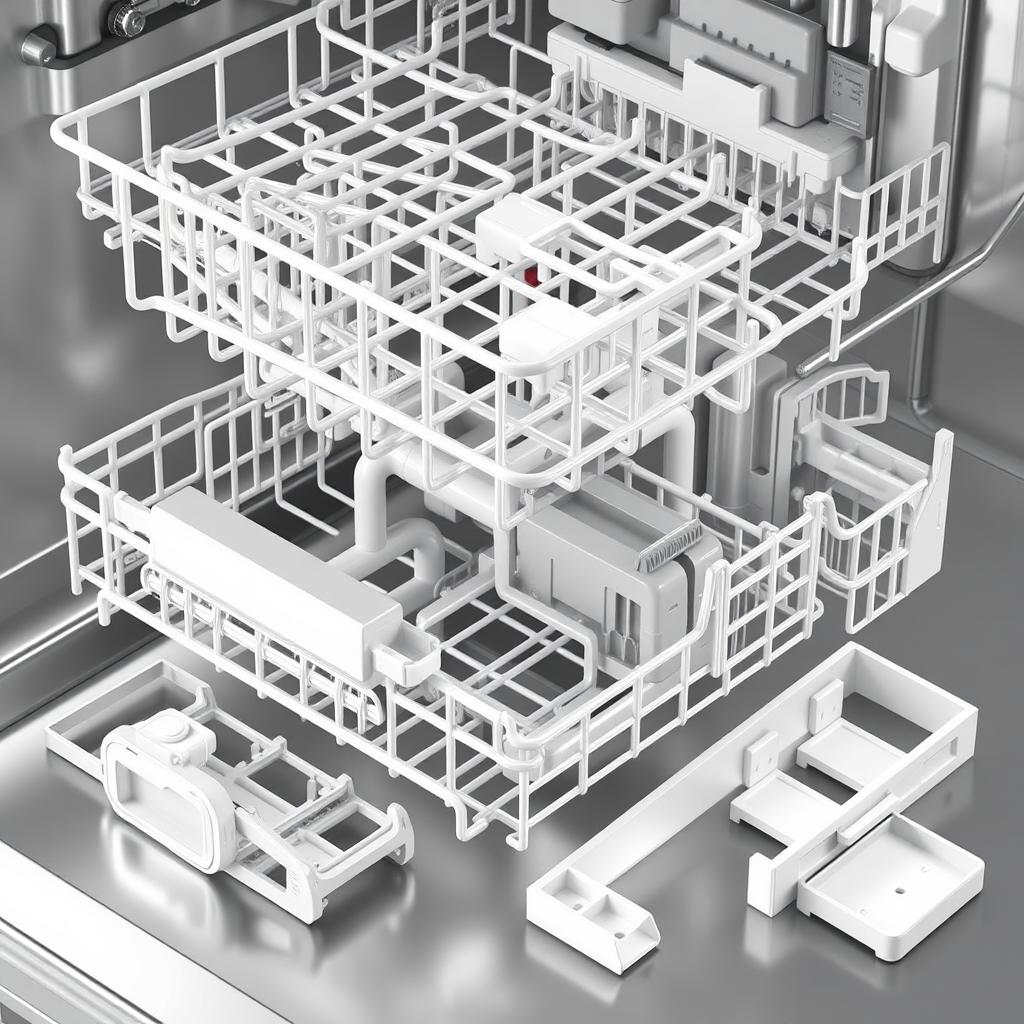
Dishwasher racks, spray arms, and interior trim utilize glass-filled nylon (PA66-GF30) and modified polypropylene. These materials offer exceptional heat resistance (up to 120°C) and dimensional stability when exposed to hot water and steam. The glass fiber reinforcement provides enhanced rigidity with flexural modulus values of 7000-9000 MPa, critical for components that must support heavy loads while exposed to harsh detergents and varying temperatures.
Small Appliance Housings
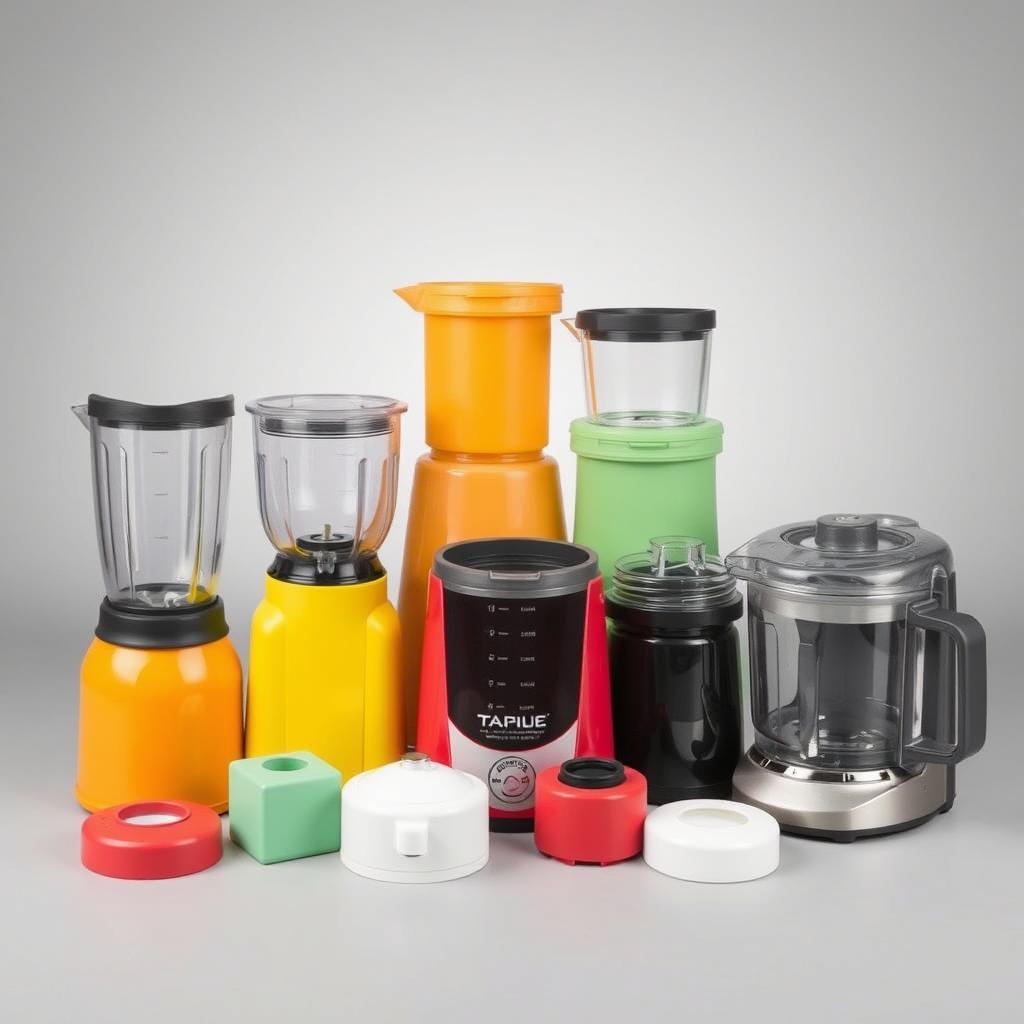
Blender housings, coffee maker bodies, and food processor components typically utilize ABS and polycarbonate (PC) blends. These materials offer excellent aesthetic qualities with high gloss surfaces (gloss units >85 GU at 60°) while providing the necessary impact strength (Izod impact >200 J/m) and heat resistance. Two-shot injection molding is often employed to create soft-touch grips and controls using thermoplastic elastomers (TPE) with hardness values of 60-80 Shore A.
Air Conditioner Components
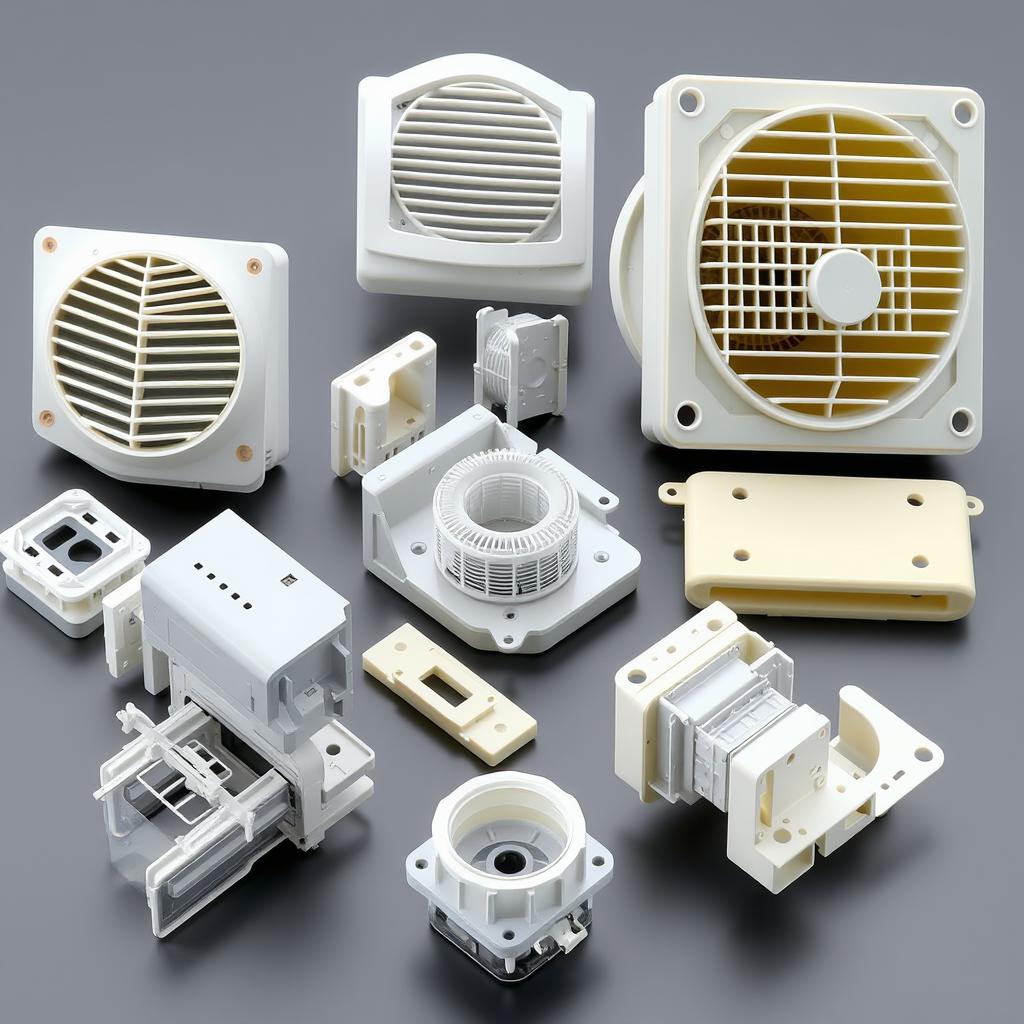
Air conditioner vents, louvers, and housing components are typically manufactured using UV-stabilized ABS and ASA (Acrylonitrile Styrene Acrylate) with UV stabilizers. These materials maintain their mechanical properties and appearance despite prolonged exposure to sunlight and temperature fluctuations. Gas-assisted injection molding is often employed for hollow sections, reducing weight while maintaining structural integrity with wall thicknesses of 2.0-2.5mm.
Microwave Components

Microwave turntables, control panels, and interior components utilize high-temperature resistant materials like PBT (Polybutylene Terephthalate) and PPS (Polyphenylene Sulfide). These engineering plastics maintain dimensional stability at temperatures exceeding 200°C with heat deflection temperatures (HDT) above 200°C at 1.8 MPa. Precision injection molding ensures consistent wall thickness (typically 2.5-3.0mm) to prevent warping during microwave operation.
Benefits of Injection Molding for Home Appliance Manufacturing
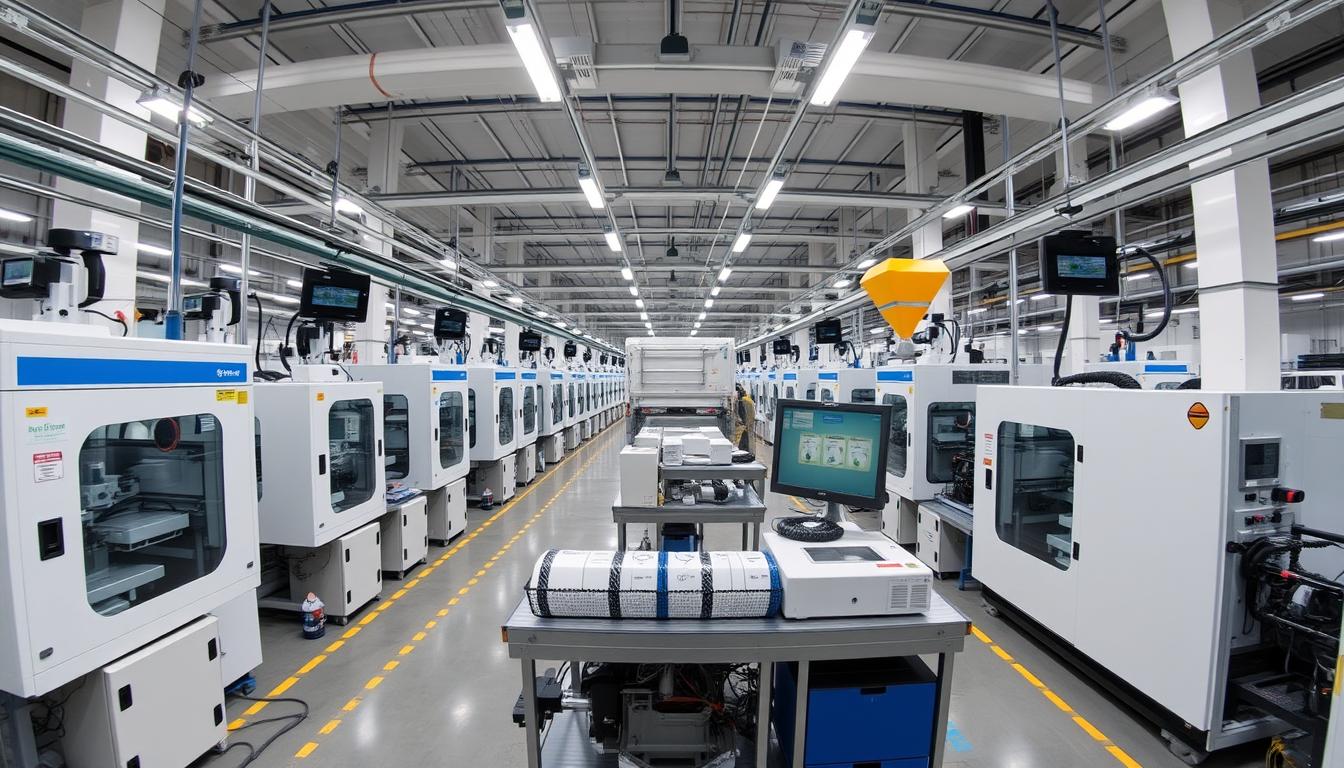
Advantages of Injection Molding
- Precision and Consistency: Modern injection molding achieves tolerances of ±0.05mm, ensuring components fit perfectly during assembly. This precision reduces assembly time by up to 35% compared to components manufactured using alternative methods.
- Cost Efficiency at Scale: While initial tooling costs range from $10,000 to $100,000, the per-unit production cost can be as low as $0.05 for simple components when produced in volumes exceeding 100,000 units.
- Design Flexibility: Complex geometries, undercuts, and intricate features can be produced in a single operation, eliminating the need for secondary assembly operations and reducing overall manufacturing costs by up to 40%.
- Material Versatility: Over 25,000 engineered thermoplastic compounds are available, allowing engineers to select materials with specific properties for each application, from heat-resistant PPS to impact-resistant PC/ABS blends.
- Surface Finish Control: In-mold texturing and decoration techniques eliminate secondary finishing operations, reducing production time by up to 50% while achieving surface finishes with gloss levels from 2 GU (matte) to 95 GU (high gloss).
Limitations to Consider
- High Initial Tooling Costs: Mold tooling represents a significant upfront investment, with complex multi-cavity molds for home appliances often exceeding $50,000.
- Design Constraints: Wall thickness variations must typically be kept within 25% to prevent warping and sink marks, limiting some design possibilities.
- Material Limitations: Not all materials are suitable for injection molding, with some high-performance polymers requiring specialized equipment due to high processing temperatures (>350°C).
- Production Volume Requirements: The economics of injection molding favor high-volume production, with break-even points typically occurring between 5,000 and 10,000 units depending on component complexity.
Optimize Your Appliance Manufacturing
Our engineering team specializes in precision injection molding for home appliances. Let us help you select the optimal materials and design parameters for your specific application.
Injection Molding vs. Alternative Manufacturing Methods
| Manufacturing Method | Precision | Production Volume | Tooling Cost | Material Options | Cycle Time | Typical Applications |
| Injection Molding | ±0.05mm | 10,000+ units | $10,000-$100,000 | Extensive (25,000+ compounds) | 15-60 seconds | Interior components, housings, control panels |
| Blow Molding | ±0.5mm | 5,000+ units | $5,000-$50,000 | Limited (PE, PP, PET) | 20-45 seconds | Water tanks, large hollow components |
| Rotational Molding | ±1.0mm | 500-5,000 units | $3,000-$20,000 | Moderate (PE, PP, Nylon) | 15-30 minutes | Large water reservoirs, bulky components |
| Thermoforming | ±0.25mm | 1,000-10,000 units | $2,000-$15,000 | Limited (PS, ABS, PETG) | 10-60 seconds | Refrigerator liners, thin-walled components |
| 3D Printing | ±0.1mm | 1-500 units | $0 (toolless) | Growing (PLA, ABS, Nylon, TPU) | Hours per part | Prototypes, low-volume custom parts |
Case Studies: Injection Molding Success in Home Appliances
Case Study 1: Washing Machine Drum Revolution

A leading appliance manufacturer faced challenges with their metal washing machine drums: high weight, corrosion issues, and costly manufacturing. By transitioning to injection-molded polypropylene with 30% glass fiber reinforcement, they achieved:
- Weight reduction of 43% (from 8.2kg to 4.7kg)
- Manufacturing cost reduction of 28%
- Improved energy efficiency due to lower rotational mass
- Enhanced design flexibility with integrated water flow channels
- Complete corrosion resistance, extending product lifespan by 35%
The injection molding process utilized gas-assisted technology to create hollow sections, reducing material usage while maintaining structural integrity. The cycle time was optimized to 45 seconds per part, enabling production of 1,800 units per day on a single molding machine.
Case Study 2: Coffee Maker Housing Innovation
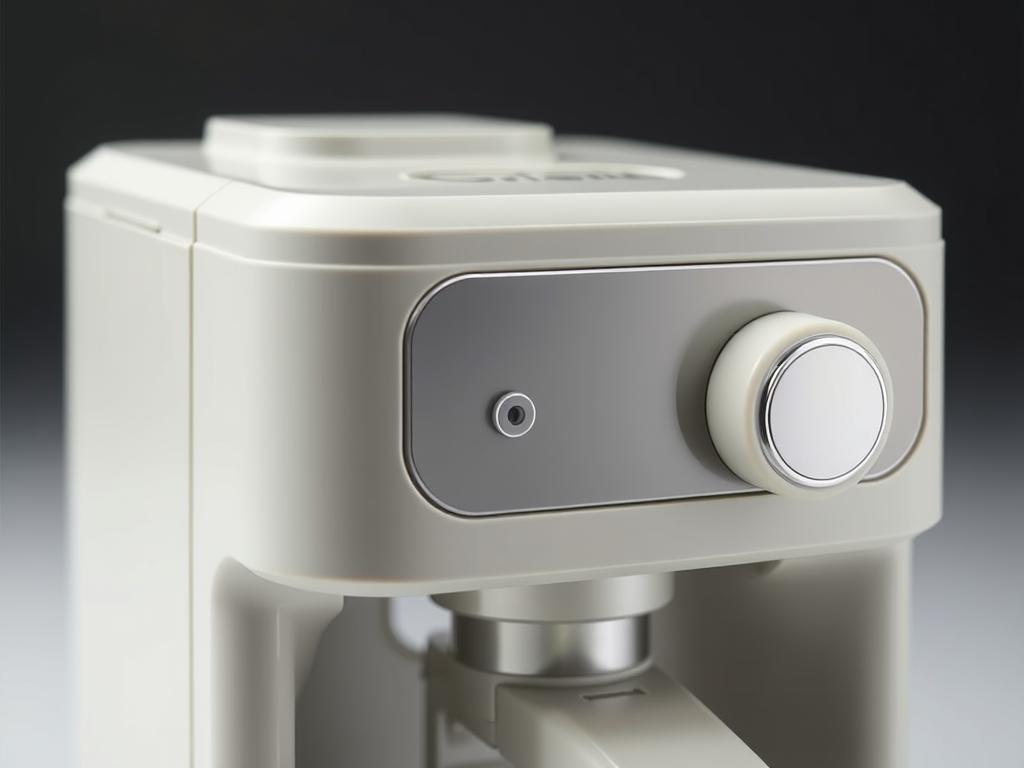
A premium coffee maker manufacturer sought to differentiate their product through both aesthetics and functionality. By implementing two-shot injection molding with PC/ABS and TPE materials, they achieved:
- Integration of hard housing and soft-touch controls in a single molding operation
- Assembly time reduction of 64% by eliminating 12 separate components
- Enhanced water resistance through integrated gaskets (IPX5 rating)
- Improved aesthetic quality with seamless material transitions
- Manufacturing cost reduction of 32% despite using premium materials
The two-shot molding process utilized a rotary platen system with a cycle time of 55 seconds. The PC/ABS material (Bayblend® T85) provided heat resistance up to 120°C, while the TPE overmold (Santoprene™ 8211-55) delivered a premium soft-touch feel with excellent chemical resistance to coffee oils and cleaning agents.
Future Trends in Home Appliance Injection Molding

Sustainable Materials

The home appliance industry is rapidly adopting sustainable materials, with biodegradable polymers and recycled content becoming increasingly common. Bio-based polymers derived from renewable resources are projected to grow at 18% CAGR through 2025. New compounds like PLA reinforced with natural fibers offer comparable mechanical properties to traditional materials, with tensile strengths of 50-60 MPa and heat deflection temperatures up to 160°C when properly formulated.
AI-Driven Mold Optimization

Artificial intelligence is revolutionizing mold design and process optimization. Machine learning algorithms analyze thousands of molding parameters to predict and prevent defects before they occur. These systems can reduce development time by up to 70% while improving part quality. Advanced simulation software now incorporates fiber orientation prediction, warpage compensation, and automated gate location optimization, reducing the need for physical prototyping and mold modifications.
Conclusion: The Future of Home Appliance Manufacturing
Injection molding has established itself as the cornerstone of home appliance manufacturing, offering unmatched precision, efficiency, and design flexibility. As consumer demands evolve toward more sustainable, feature-rich, and aesthetically pleasing appliances, injection molding technology continues to advance in parallel. From the integration of smart materials with embedded sensors to the adoption of AI-driven process optimization, the future of injection molding in home appliances promises even greater innovation.
For appliance manufacturers, staying competitive requires partnering with injection molding specialists who understand both the technical requirements and market trends driving the industry forward. By leveraging the latest advances in materials, mold design, and processing techniques, manufacturers can reduce costs, improve quality, and bring innovative products to market faster than ever before.
Transform Your Appliance Manufacturing
Our engineering team specializes in advanced injection molding solutions for the home appliance industry. Contact us today to discuss how we can help optimize your manufacturing process.

